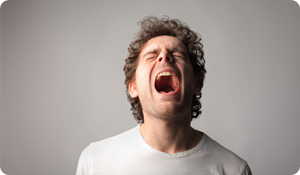
More than 76 million people report having suffered from pain lasting more than 24 hours, according to the American Pain Foundation. While one person can get a simple paper cut and feel that its agonizing pain, another person can break a bone and find it to be a minimal pain. What's going on here?
Each person has a different threshold and tolerance for pain.
What Determines Pain Tolerance?
According to staff at the Mayo Clinic, how you interpret pain messages and tolerate pain can be affected by your:
- Emotional and psychological state
- Memories of past pain experiences
- Upbringing
- Age
- Sex
- Beliefs and values
- Social and cultural influences
- Attitude
- Expectations
In other words, your experience of pain is part biology and partly influenced by psychological and cultural factors.
For example, if you were raised in a home or culture that taught you to "Grin and bear it," you may experience less discomfort than do people who focus on their pain or who are more prone to complain. Likewise, if you are an athlete who has conditioned yourself to endure pain, you might experience an injury that would incapacitate others.
The following are some additional factors medical experts say can influence pain tolerance:
- Depression and anxiety can make a person more sensitive to pain.
- People who smoke or are obese report more pain.
- Biological factors--including genetics, injuries such as spinal cord damage, and chronic diseases such as diabetes that cause nerve damage--also shape how we interpret pain.
While many Americans turn to pain medications to relieve pain, the medications aren't necessarily the best answer over the long run since they don't actually heal the source of pain.
Tips to Prevent and Manage Pain
Below are some tips prevent and manage pain.
- Exercise. While you may not feel like exercising when you are in pain, exercise is actually one of the best antidotes for pain. When you exercise, you release endorphins, the body's natural pain-relieving chemicals. Schedule 30 minutes of moderate-impact physical activity at least 3 days a week. Walking, swimming, or bicycling are good choices.
- Stretch. If you suffer from any type of physical pain, you will benefit from stretching. Like exercise, stretching releases endorphins in your body for pain-relief, and also helps circulate stagnated energy that might be the source of your pain. Start and end your day with 15 minutes of easy stretching. You may also want to attend yoga class. Talk with the instructor beforehand to let them know about any specific pain issues you are having.
- Meditate. Sit quietly in a comfortable position (use a chair if you need one). Breathe in slowly to the count of fove. Hold your breath for two counts. Breathe out slowly to the count of five. Hold the breath out for two counts. Repeat. This practice will help shift the pattern of your brain waves, and help quiet the voice that is saying, "I feel pain ... I'm in so much pain, etc."
- Take the focus off the pain. Sports experts advise that if you concentrate on pain rather than concentrate on your sport, the pain will increase and interfere with your performance. The same applies to daily living. If you concentrate on the pain, it will interfere with your daily experiences. When you catch yourself thinking about the pain, take a deep breath, you're your body around, and think about something that makes feel happy.
- Biofeedback. Biofeedback uses special equipment to help make you more aware of your body's reaction to stress and pain. The techniques can help you learn to better relax your muscles and control your response to pain. Talk to your doctor for recommendations.
Note: If you are experiencing acute pain or chronic pain that is debilitating, contact your doctor.
Sources:
American Pain Foundation: "Pain Facts & Figures." Web. 18 May 2010. http://www.painfoundation.org/newsroom/reporter-resources/pain-facts-figures.html
Mayo Clinic Staff. "How You Feel Pain." MayoClinic.com. Web. 18 May 2010. http://www.mayoclinic.com/health/pain/pn00017
O'Connor, Eddie. "Pain Tolerance in Sport." Association for Applied Sport Psychology. Web. 19 May, 2010. http://appliedsportpsych.org/Resource-Center/Athletes/Articles/paintolerance
Sharples, Tiffany. "Bleep! My Finger! Why Swearing Helps Ease Pain." Time. 16 Jul. 2009. Web. 19 May 2010. http://www.time.com/time/health/article/0,8599,1910691,00.html





